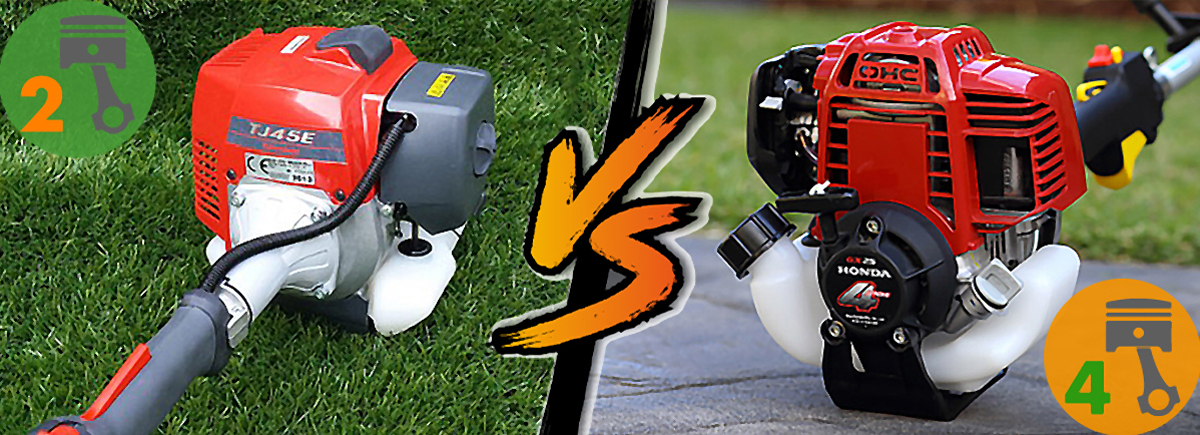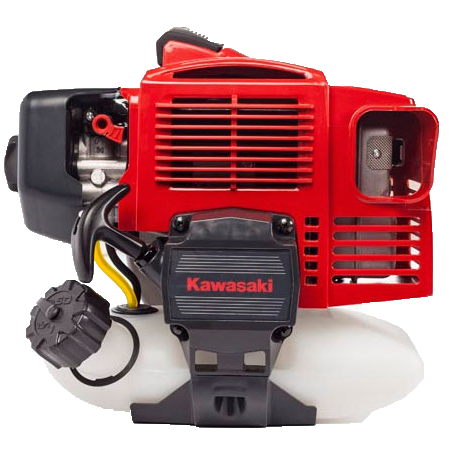A comprehensive guide to help you choose between a 2-stroke and a 4-stroke brush cutter, with all their differences and features.
The Complete Guide to help you choose between 2-stroke or 4-stroke Brush Cutter
by the Real Experts of Gardening Machinery
When buying a new brush cutter, is it better to move towards a classic 2-stroke brush cutter or a modern 4-stroke brush cutter?
This question is asked very frequently when one is about to make this expense, and it is often difficult to find the right answer.
Which of the two types will be the easiest to operate? Which is the most reliable and durable? Which one is the easiest to start? Which type is the most suitable for a large surface area or intensive and prolonged work? Which one is the best for small domestic jobs? And which one of the two engines requires less maintenance?
In the following guide, we will try to give an exhaustive answer to all these questions.
CONTENTS
1. Displacements, power and weight
First of all, an introduction should be made to the available capacities for both technologies. Two-stroke engines have been the main component of brush cutters since their appearance on the market over 50 years ago. For this reason, engines of all possible displacements have been developed over the years. It’s possible to quickly classify them according to size/power/weight:
| 20 – 29 cc | small displacements | power range: 0,7 – 1,0 HP | Weight: 5 – 6 kg |
| 30 – 34 cc | medium – small displacements | power range: 1,1 – 1,3 HP | Weight: 6 – 6.5 kg |
| 35 – 40 cc | medium displacements | power range: 1,4 – 1,6 HP | Weight: 6.5 – 7 kg |
| 41 – 46 cc | medium – large displacements | power range: 1,7 – 2,0 HP | Weight: 7 – 7.5 kg |
| 47 – 54 cc | large displacements | power range: 2,1 – 2,4 HP | Weight: 7.5 – 8.5 kg |
| 55 – 65 cc | very large displacements | power range: 2,5 – 3,0 HP | Weight: 9 – 10 kg |
The first 4-stroke engines began to be employed in brush cutters about 10 years ago, and during that time they have made their way into the market, although they are still somewhat less popular than 2-strokes. They start with the same displacements as 2-stroke ones, but stop at smaller displacements than the two-strokes, due to the difficulty manufacturers have in developing large yet lightweight 4-stroke engines suitable to be fitted on brush cutters. However, two major brands have recently paved the way for displacements above 40 cc: Honda, with a powerful and highly efficient new 50 cc engine (GX 50), and then Makita, with its 43 cc new engine. 4-stroke engines can be classified according to size/power/weight:
| 20 – 29 cc | small displacements | power range: 0,6 – 0,9 HP | Weight: 5.5 – 6 kg |
| 30 – 34 cc | medium – small displacements | power range: 1,0 – 1,1 HP | Weight: 6.5 – 7 kg |
| 35 – 40 cc | medium displacements | power range: 1,2 – 1,4 HP | Weight: 7 – 7.5 kg |
| 41 – 50 cc | large displacements | power range: 1,5 – 2,0 HP | Weight: 8 – 9 kg |
- (20-29)
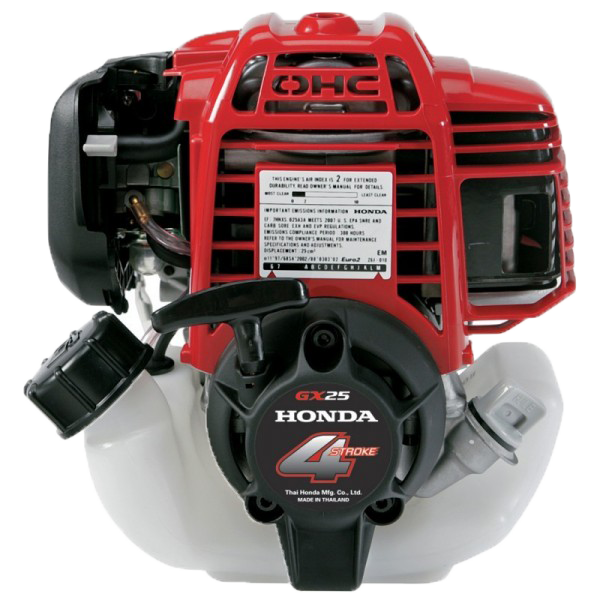
(20-29 cc) - (30-34)

(30-34 cc) 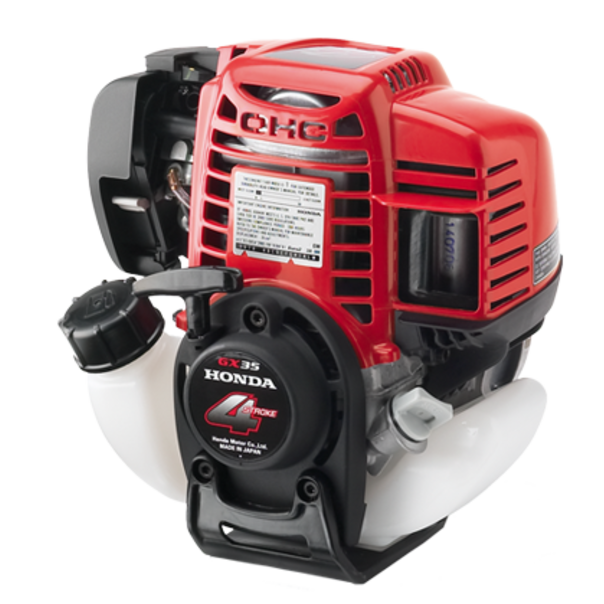
(35-40 cc) 
(41-50 cc)
If we compare the same displacement classes above, it seems clear that the 4-stroke brush cutter has two slight disadvantages compared to the 2-stroke:
- on average about 0.5 KG heavier
- on average about 0.2 HP less power
A third disadvantage that does not appear in the tables above is the following:
- less torque than 2-stroke engines with the same displacement
We can therefore draw an initial conclusion: 4-stroke brush cutters have a less positive power-to-weight ratio (higher weight and lower power) than 2-stroke ones.
2. Construction technologies: pros and cons
In summary:
The strengths of the 2-stroke engine are:
- Constructive simplicity
- Longer life (*on professional brands)
- Lower weight
- Increased reliability under heavy-duty use
The strong points of the 4-stroke engine are:
- Advanced technology
- High fuel efficiency
- Great smoothness of operation
In conclusion, even in this section, the 2-stroke brush cutter would seem to prevail over 4-stroke in many respects.
In the following chapters, however, we will see how the 4-stroke engine has features that make it sufficiently competitive against the 2-stroke.
3. Ease & comfort of use
As far as these factors are concerned, the 4-stroke engine definitely has an edge over its counterpart.
It is clear that the 2-stroke brush cutter is also a very practical machine to operate, even by less experienced users, but it requires a little more attention than the 4-stroke.
3.1 Fuel preparation
- 4-stroke:
- no fuel-oil mix preparation required, the user simply needs unleaded petrol
- the fuel should be used fresh, but plain gasoline preserves better than fuel-oil mixture (we recommend not using petrol older than 4 months)
- 2-stroke:
- The mix must be prepared each time before use, with the appropriate oil in the right percentage (often 2% or 2.5%). Care should be taken to purchase synthetic oil, which gives a better guarantee of correct engine lubrication;
- The fuel must be used very fresh, in fact, the mixture does not preserve as good as plain gasoline, and unleaded petrol is a very aggressive fuel and tends in the long term to deteriorate the lubricating characteristics of the oil (we recommend that you do not use a mixture older than 2 months).
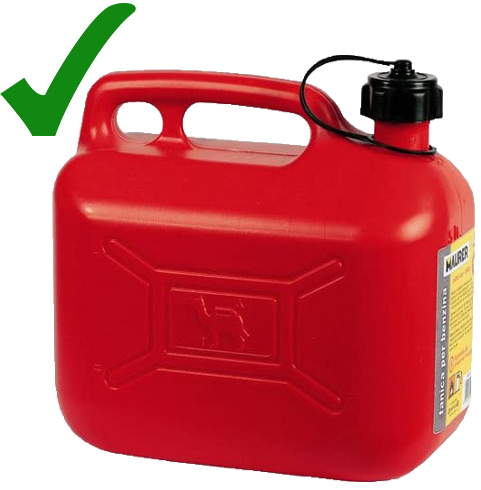
(Standard fuel tank) 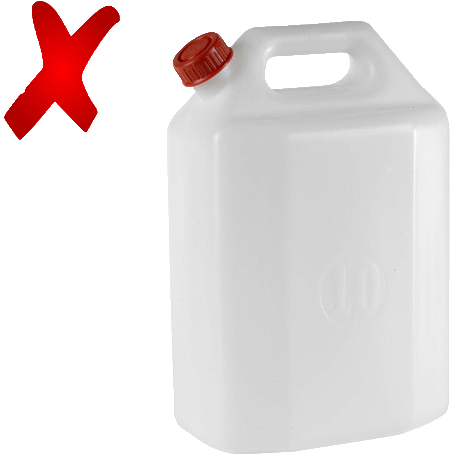
(NON standard transparent fuel tank) 
(Fuel-oil mix preparation kit)
Transparent fuel tanks, besides not being compliant due to the limited thickness of the plastic and the type of dispensing caps, which are not suitable for flammable fuels, they also have the major problem of the transparency, which allows ultraviolet rays to pass through them, causing fuel (both fuel-oil mix and gasoline) to deteriorate and do not preserve properly.
3.2 Start-up
Today, starting-up procedures have become perfectly reliable on both 4-strokes and 2-strokes, so any good brand of either technology will be started-up easily in 2/3 pulls. However, the 4-stroke engine has an even more immediate start-up than the 2-stroke one and the reasons for this are as follows:
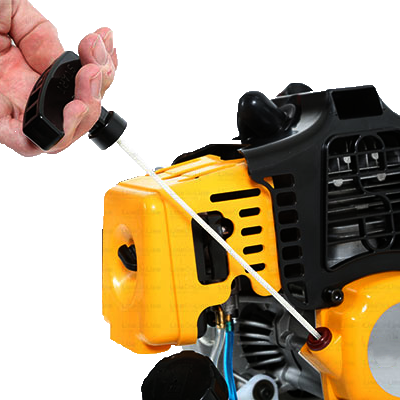
- 4-stroke:
- it has a lower compression, so it requires less force to pull on the starter rope
- the user closes the air lever, then gives the first pull. Very often, if the brush cutter is of a renowned brand, it starts at the first pull, giving the operator enough time to place the air lever again to the normal position with the engine still running.
- 2-stroke:
- higher engine compression, especially as displacement increases, requiring more force to pull on the starter rope.
- it usually requires 2 or 3 pulls with the air lever closed, and after it gives the sign of a combustion crackling, by returning the air lever to the normal position, 1 or 2 additional pulls are needed for the final start-up.
3.3 Comfort of use
The main elements of comfort for the operator during use are two: the level of vibrations transmitted by the machine to the operator, and noise emissions.
- 4-stroke:
- reduced vibration level (due to the combustion mode of the 4-stroke engine)
- lower noise emissions, that allow the operator to work at an excellent level of comfort with limited noise pollution (also due to the combustion mode of the 4-stroke engine)
- 2-stroke:
- higher vibration level (due to the peculiar operation of this type of engine and its higher engine speed), although this is now partly reduced by modern anti-vibration systems;
- increased noise levels, typical of two-stroke engines, especially on large displacements (although technology has led to the development of very efficient silencers)
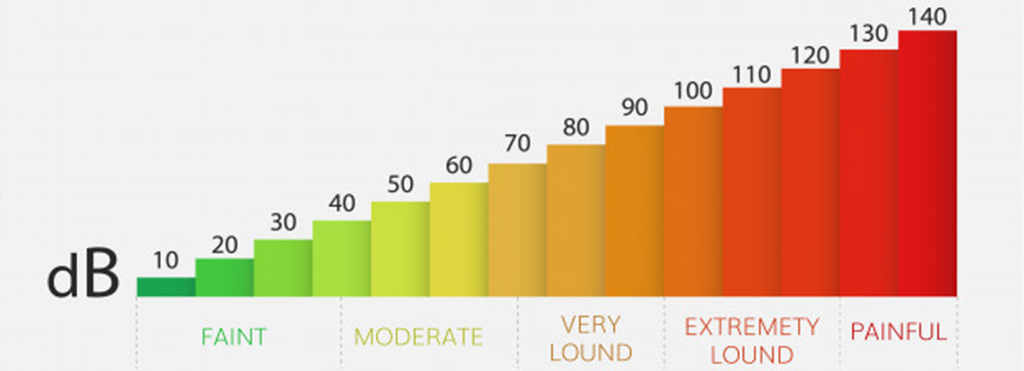
3.4 Consumption and emissions
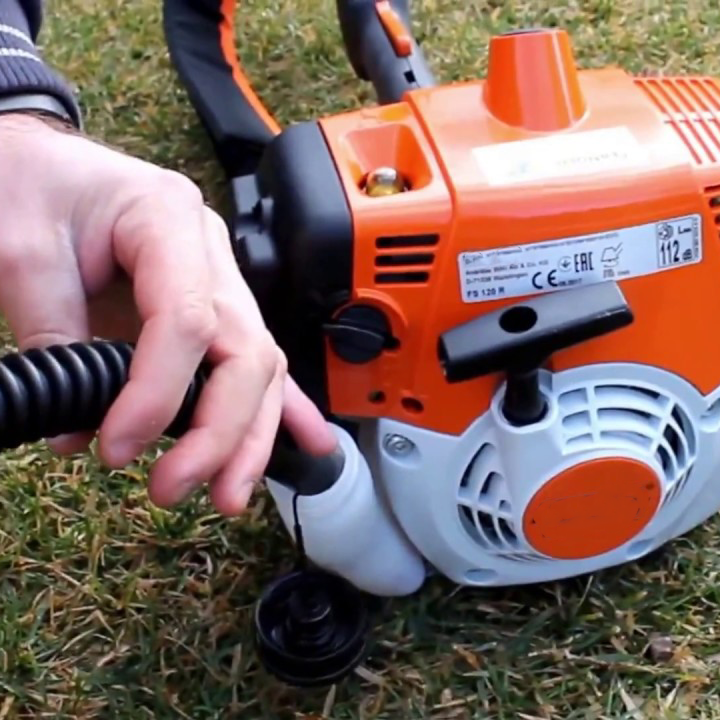
Also in this section, as in the previous one, there is a strong case for 4-stroke engines due to their high efficiency in the fuel combustion process.
Consumption: thanks to the 4-stroke operation itself, the fuel consumption is half that of a 2-stroke brush cutter! It is also ideal for not very intensive use which needs only occasional fuel refill.
Brush cutter tanks can have different capacities, generally from 0.5 litres up to 1 litre.
The average duration of a full tank of fuel for the two types of engine is as follows:
- 4-stroke: approx. 2 hours (of continuous heavy-duty work)
- 2-stroke: approx. 1 hour (of continuous heavy-duty work)
Emissions: directly related to the previous topic, if fuel consumption is lower, clearly emissions will be too.
Actually, the emissions from a 4-stroke brush cutter are even less than proportional to the actual fuel consumed, because there is no oil in it: it only burns petrol, not a mixture (fuel mixed with oil).
In the case of the fuel-oil mix, the polluting emissions are mainly linked to the oil particles that remain unburned and are released into the atmosphere, producing the classic white cloud of smoke.
On the other hand, the 4-stroke engine, due to the efficiency of the combustion system, releases very few unburnt fuel particles, and, above all, they contain no traces of oil.
As a result, the 4-stroke engines do not produce the classic cloud of smoke, which is very comfortable for the operator, who can work without breathing exhaust fumes.
3.5 Maintenance
The level of maintenance required by both types of brush cutter is very similar, so there is not one type that prevails in this respect.
First of all, it is worth pointing out the two main maintenance recommendations that must be carefully observed on both engines in order to avoid problems with operation:
- 4-stroke: oil level check/oil change
The 2-stroke engine has oil inside it (located inside the so-called oil sump), and therefore the right amount of specific oil must be filled before the first use.
This should be checked periodically (at least once every two uses) and topped up if the level has dropped. A cap with a level control dipstick makes the operation extremely easy.
- 2-stroke: removing fuel from the tank for long periods of inactivity
As explained in the previous sections, the mixture does not preserve and tends to quickly lose its properties (particularly the lubricating properties of the oil it contains). This is why fuel must be removed from the tank during long periods of inactivity (e.g. during winter). Some people also advocate starting the engine up, after removing the fuel, to let the residual mixture left in the circuits and carburettor burn off, but this is a bad practice. This should be retained in order to maintain a certain degree of humidity in the carburettor. Otherwise, if left completely dry, any oil residue in it could dry out and damage the carburettor diaphragms.
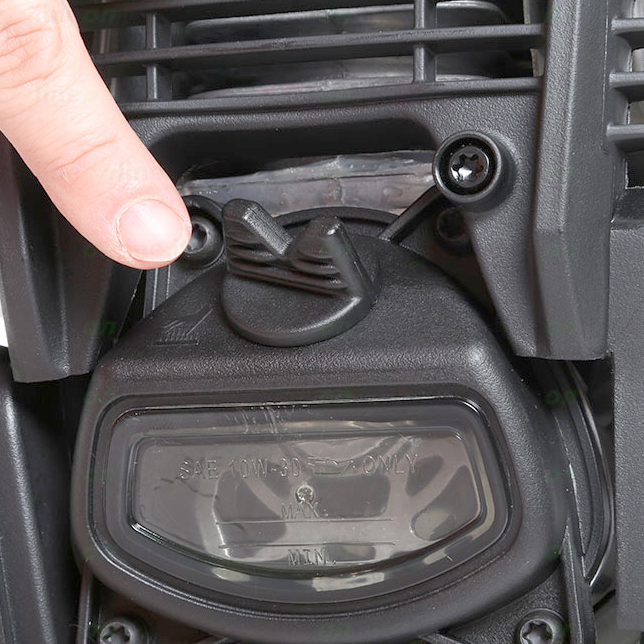
(Checking the oil level) 
(Removing fuel from the tank)
Other classic maintenance operations to be carried out on both engines:
- Checking, cleaning or replacing of the spark plugs
- Air filter cleaning
- Greasing the right angle gear reducer (bevel gear) at the bottom of the transmission shaft

(Spark plug cleaning) 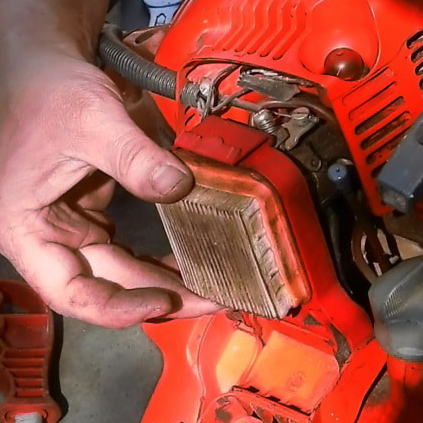
(Air filter cleaning) 
(Greasing of bevel gear)
For a detailed discussion on 2-stroke engine maintenance, we recommend you read the specific guide.
4. Professional use – Hobby use – Price range
This concluding section deals with some recommendations based on usage and type of user.
4.1 Price
Both types of engines come at a wide range of prices, from the most cost-effective models of brush cutters, to the more expensive ones manufactured by premium brands (e.g. Honda engines for 4-strokes or Kawasaki engines for 2-strokes).
However, given the greater manufacturing complexity, for the same quality level of the product or brand, and with the same displacement, the price of a brush cutter with a 4-stroke engine is on average 20% higher than that of a 2-stroke brush cutter.
4.2 Professional use – 2-stroke
Based on all the previous sections, a 2-stroke brush cutter (preferably from a renowned brand) is definitely recommended for professional, or at least intensive or heavy-duty use. The reasons are summarised below:
- More power (hence higher productivity to get the job done)
- Less weight (in intensive or prolonged use, less weight for the operator reduces fatigue)
- Increased durability (the engine has a more essential design for users who focus on performance)

4.3 Limited use and less-experienced users – 4-stroke
Brush cutters equipped with 4-stroke engines are perfectly suitable for all users who have no particular mechanical skills, and need a tool with simple operation and a high level of comfort. The users targeted by this technology do not make heavy or intensive use of these machines, but rather a more “hobby” use. The reasons are summarised below:
- Ease of use (no fuel-oil mixture preparation and easy cold start)
- Comfort of use (less vibration and fewer noise emissions)
- Low fuel consumption and emissions (no polluting smoke)

In conclusion, it should be noted that the continuously growing technological development in the field of 2/4-stroke engines is investing a lot of energy in producing mainly 4-stroke engines, because of their low level of pollution. In fact, the manufacturers’ efforts are increasingly focused on developing and improving 4-stroke engines, in an effort to raise them to the rank of professionals, like 2-stroke ones.
This became abundantly clear from the latest model introduced to the market: the Honda GX 50, a very powerful engine which, although it does not reach the power of strictly professional 2-stroke engines over 50cc, proves to be equally efficient. Therefore, brush cutters fitted with the new Honda GX 50 qualify as professional level machines.




